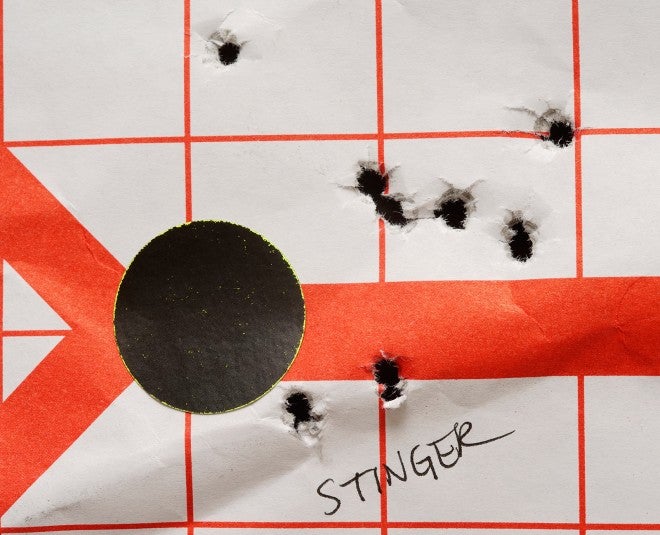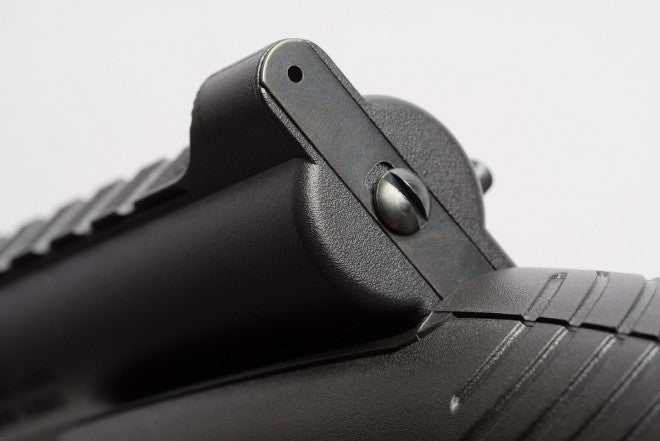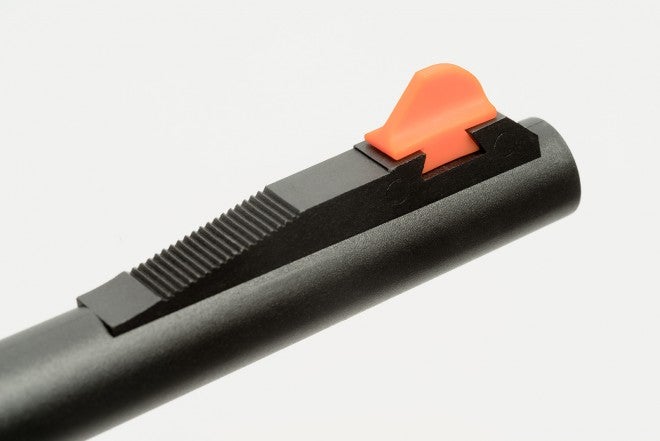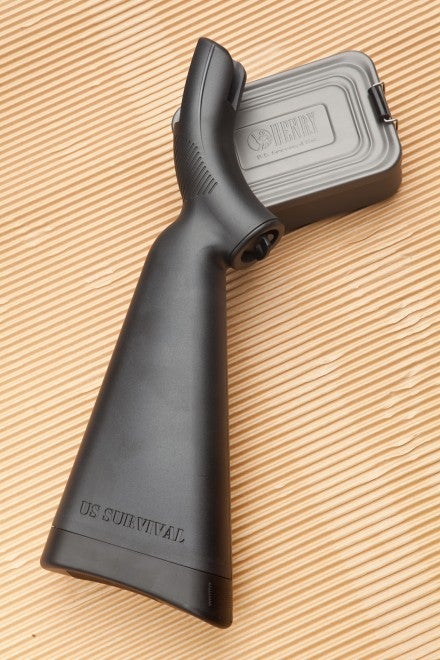Another Look at the Henry AR7
Oleg Volk 04.06.15

Henry AR7 survival rifle has been covered extensively, but I would like to add my own observations to the article pile. Produced first by Armalite and Charter Arms, AR7 had a reputation for indifferent reliability. I am happy to report that the Henry variant proved very reliable with a variety of ammunition. I tested this gun right out of the box with no additional lubrication and no adjustment of sights.
The assembly process is very simple and obvious. Disassembly for cleaning is as simple. For a field rifle, that’s a major plus. Henry web site provides detailed video tutorials that supplement the abbreviated instruction manual shipped with the AR7.
I test fired it with CCI Mini Mags (40gr) and Stingers (32gr), Winchester Supreme Xpediter (32gr) andFederal bulk 550rd pack (40gr). Cycling was 100% with all but the Xpediter load, which wouldn’t feed at all. The bolt rebounded too quickly, mangling the next cartridge. Which brings me to the important point: always clear AR7 malfunctions with the muzzle pointed down. When pointed up, it provides enough of an opening between the bolt and the receiver to drop an whole live round into the mechanism, requiring careful shaking to get it out of the action. That process works best with the barrel removed.
The inability to feed hypervelocity ammo isn’t much of an issue in my mind. In an emergency, it can be fed one round at a time for hunting, but the other hypervelocity round proved least accurate of all tried, with the group exceeding 1.5″ at 25 yards. Hole in paper showed a hint of keyholing. The instruction manual advises the use of standard or high velocity 40gr ammunition only.
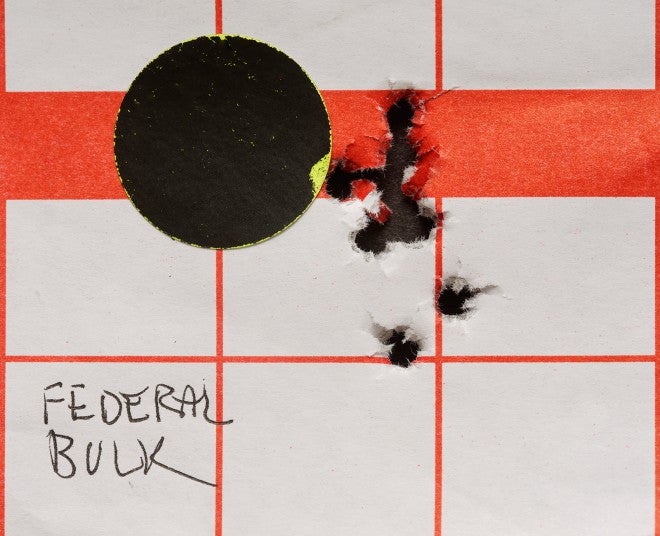
The plastic sight hood provides the sight picture with excellent contrast. The metal rear sight plate is reversible, with a smaller peep on the other side of it. For precision shooting in good light, that would be preferred. For defensive use, the entire sight plate may be removed, with the sight hood acting as a ghost ring. The sight plate may be moved up and down for elevation adjustment. I would suggest picking your favorite load and zeroing for it at 25 yards, which would give fairly close point of impact out to 50 or so. It’s worth putting a witness mark on the plastic on both sides of the sight so as to avoid damaging the bluing of the metal part. I would have preferred an etched scale on the rear sight to provide repeatable adjustments.
The front sight is a metal ramp with a highly visible dovetailed plastic blade. It is adjustable for windage with nothing more than firm finger pressure. Since the sight is not protected in any way, I would highly recommend securing it in place with a drop or two of glue after zeroing. Functionally, the sights are excellent. Despite the heavy trigger, better accuracy than mine is entirely possible without resorting to a scope: better shooters reported 5-shot groups closer to 1/2″ at 25 yards. Despite the back-heavy look, the rifle is well-balanced and can be steadied effectively by squeezing of the stock with both elbows, a technique similar to how bullpup rifles are held for deliberate fire. The rifle helpfully keeps the point of impact similar for different brands and even weights of bullets.
Nearly 21 inches of sight radius–longer than on a full-length M16–set AR7favorably aside from its direct competitors. It is likely that practical accuracy could be further improved by the use of optics, but the rimfire-sized rail on top of the receiver will not take optics designed for Picatinny standard. That rules out most quick-detach mounts, leaving us primarily with rimfire-specific sights. Given the mechanical accuracy of the rifle and the intended targets, small game, 2.5x to 4x scope may be appropriate for people whose eyes are too tired for iron sights. Crickett 4x scope with parallax set at 35 yards is one possible option, plenty of others exist. The main down side to the use of optics is the bulk, the weight and the loss of stowage capability. Any optic would have to come off before the rifle components would fit into its stock. My own preference would be to forgo optics and carry additional magazine and ammunition for the same weight.
Disassembled and stowed, the rifle is mostly waterproof and can be exposed to rain with impunity. While was designed to float, the real value is in the ability to keep it safe from the elements, along with two loaded magazines. Besides rain, the same tight seal would also keep out dust and sand. Because the assembly-reassembly isn’t an instant process, and most people would prefer to carry it ready for use, the rifle would benefit from a sling. With the balance point on this rifle being just aft of the trigger guard, it works well with aftermarket or improvised single-point sling around either the pistol grip or the middle part of the buttstock. At 3.5lbs loaded and with a second magazine stowed in the stock, the weight won’t be an issue on long hikes. The user does have to watch the muzzle position when sitting or squatting to avoid sticking it into mud or dirt.
Accuracy is a very important consideration with survival rifles. The most likely small game in North America, rabbits, have an effective kill zone of about an inch in diameter. Body hits are an option for longer ranges, but would damage more meat, especially if the digestive tract is penetrated. With squirrels, the kill zone is even smaller, and none of the small game are likely to permit a follow-up shot.
The charging handle is fairly thin and retracts into the bolt when not in use. Although it feels insubstantial, I’ve seen no complains about breakage. In cases where dirt or a defective casing prevent extraction, the entire barrel can come off quickly, a big plus for the design.
The on-going debate, should survival rifles be semi-automatic or manually operated, probably depends on the scope of intended use. For a purely hunting gun, manual operation gives the ability to use pretty much any 22LR and shorter ammunition found without problems. The same, of course, is possible with AR7 in single shot mode. But the rapid follow-up and box magazine feed give the AR7 at least a last-ditch defensive utility in a compact lightweight package.
The extensive use of plastic, besides saving weight, also reduces the heat transfer between the stock and the face in hot or cold weather. For this reason, I would favor the camouflage patterned edition of the rifle; it would heat up less in the sun and be slightly less obvious as a rifle to other people from a distance. While wooden stocks have the same insulating advantage, I am puzzled by the bare metal stocks being offered on rifles positioned as survival implements for all kinds of weather.
In sum, the AR7 turned out to be a far more useful and capable instrument than I expected based on the unorthodox design.
